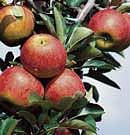A sweet thaw, that

Harish Negi’s apple orchard is in full bloom and he wants his children to return home. It is likely they will after completing their education in Shimla and Chandigarh. “Why should they stay back in the city? We now have here all that we need,” said the 50-year-old from Kinnaur district’s Sangla block, who, among other things, recently acquired an LPG gas connection.
Six years ago, Harish earned Rs three lakh from eight bighas (0.64 ha) annually. Things began to change as the cold months lost their bite in these high altitudes. Production increased and Harish went on buying more land. Today, he owns 19 bighas (1.5 ha) and makes eight times of what he did six years ago. The past six years have been a revolution of sorts, said Inder Bhagat, panchayat secretary of Batseri, a high altitude village in Sangla.
Over 90 per cent of the villagers have turned from cereals and beans to apples, he said. Harish is among them.
Production and the area under apple cultivation have increased in the upper regions such as Kaza and Tabo between 1998 and 2008: production was more than double in Kinnaur district; it increased eight times in Lahaul and Spiti districts, and one-and-a-half times in Shimla district.
Thaw helps farmers
Villagers in the higher regions have switched to apples because the climate there has become more conducive. Earlier, it was covered in snow most of the year. And farmers are making the most from this thaw. “Some farmers have businesses worth Rs two-three crore,” said S S Mehta, deputy director of Kinnaur’s horticulture department. By contrast, Himachal’s middle and lower belts, famous for their sweet apples, are suffering losses. According to the state horticulture department, the projected apple produce is around 0.2 million tonnes this year, compared to over 0.5 million tonnes last year. Sweet apples need over 1,000 hours of chilling every season. This is becoming difficult in the middle and lower regions. “This year, there was no snowfall. Then, drought followed,” said Jitendra Sarkek, orchard owner in Shathla village in Shimla. The average winter temperature in Shimla this year was around 12°C. So, chilling did not happen, said Ravinder Chauhan, president of the Apple Growers’ Association in the state. In fact, for the past 40 years, the average winter temperature (January and February) in Shimla has been increasing by 0.01°C every year, said Manmohan Singh, director of India Meteorological Department.
Therefore, unlike their counterpart in the higher reaches, farmers in these regions, with help from the state’s horticulture department, are fast taking to growing sour varieties. Most plantations in these regions are old and the trees have lived full lives. When planting anew, farmers clearly show a preference for the sour varieties. These have a shorter gestation; they start bearing fruit in four years. Sweet varieties take eight years to start fruiting.
Sweet or sour, apples have their market. The sour varieties sell because they reach the market in July, two months before the official apple season. In Delhi, these cost Rs 1,100-1,500 per box containing 20 kg of apples. The sweeter varieties from Kinnaur are more popular though. They sell for Rs 1,600-2,200 in the capital.
Impact of changing climate pattern
“The changing climate pattern is causing a change in the cropping pattern,” said Gurudev Singh, director of the state horticulture department. “The roots of these sour apple varieties, called Spur, are imported from the US and grown on clonal rootstock,” said Singh.
A rootstock is clonal when it is multiplied in a nursery from a root and not seed. When it becomes a sapling, the horticulture department sells it to farmers. “Farmers graft varieties of their choice, Spur for example, on to the sapling,” said Chauhan.
Experiments with foreign rootstock started in early 2000; the practice has picked up in the last two years. Plants grown on clonal rootstock are distinguished from other trees by low height, uniformity in fruit size, colour, and early fruiting. The trees do not survive beyond 40 years, against trees grown from seeds that live up to 70.
“One can have dense plantations (from the imported variety) and therefore more fruits,” said Krishan Kumar of Dr Yashwant Singh Parmar University of Horticulture and Forestry in Solan. “The trees can combat soil diseases,” he added. A sapling costs about Rs 500. The horticulture department subsidises it and sells it for Rs 150 each. They are difficult to grow in the higher regions because they have shallow roots and need assured irrigation, which is difficult there,” said Mehta of the horticulture department.
Harm from hydel projects
The department promotes mildly sour varieties such as Gaela and Red Fuji because these are self-pollinating. “The flowering season lasts 15-20 days. When there is a thunderstorm, bee activity gets limited, resulting in no pollination. These varieties will take care of that problem,” said Singh. Another problem that affects apples growers in the state is dust because of hydel projects. “Considering the rate at which hydel projects are being constructed, I am not sure how long Kinnaur will be able to retain the reputation of producing the best apples,” said Jaichand Negi of Kinnaur’s Chagaho village. But, above all, said Sarkek, everything depends on climate. “If the climate is congenial, we get quality apples, a good produce and a reasonable price. What if the climate continues to change and irrigation becomes a problem in the lower and medium regions?” he asked.
Deccan Herald is on WhatsApp Channels| Join now for Breaking News & Editor's Picks